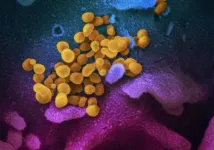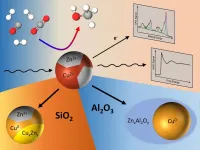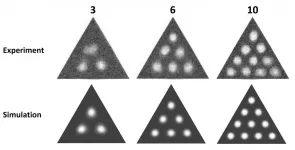Do known drugs help against SARS-coronavirus-2?
2021-03-04
(Press-News.org) There are no therapeutics available that have been developed for COVID-19 treatment. Repurposing of already available medication for COVID-19 therapy is an attractive option to shorten the road to treatment development. The drug Camostat could be suitable. Camostat exerts antiviral activity by blocking the protease TMPRSS2, which is used by SARS-CoV-2 for entry into cells. However, it was previously unknown whether SARS-CoV-2 can use TMPRSS2-related proteases for cell entry and whether these proteases can be blocked by Camostat. Moreover, it was unclear whether metabolization of Camostat interferes with antiviral activity. An international team of researchers around Markus Hoffmann and Stefan Pöhlmann from the German Primate Center (DPZ) - Leibniz Institute for Primate Research has now shown that SARS-CoV-2 can use several TMPRSS2-related proteases for its activation. These proteases are expressed in the upper respiratory tract and are blocked by Camostat. In addition, the researchers found that Camostat and its major metabolite GBPA inhibit SARS-CoV-2 infection of primary human lung tissue. These findings support the further development of Camostat and related compounds for COVID-19 therapy (EBioMedicine).
SARS-CoV-2 depends on activation by the cellular protease TMPRSS2 for infection of lung cells. The researchers of the Infection Biology Unit of DPZ previously documented that the drugs camostat and nafamostat, which are used in Japan to treat inflammation of the pancreas, block SARS-CoV-2 infection by inhibiting TMPRSS2. However, it was unknown whether Camostat metabolites also block SARS-CoV-2 and whether the virus may use TMPRSS2-related proteases for infection that may be Camostat-insensitive.
An international team of researches around Markus Hoffmann and Stefan Pöhlmann from the Infection Biology Unit of the DPZ has now shown that SARS-CoV-2 can use several TMPRSS2-related proteases for infection, among them TMPRSS11D and TMPRSS13. These proteases may support viral spread in the upper respiratory tract and are blocked by Camostat. This finding indicates that switching to activators other than TMPRSS2 might not allow the virus to replicate in the presence of Camostat.
The researchers could show that not only Camostat but also a major Camostat-metabolite, GBPA, block TMPRSS2 and SARS-CoV-2 infection. "In the human body Camostat is rapidly converted to GBPA. Therefore, it was crucial to demonstrate that not only Camostat but also GBPA exert antiviral activity", says Stefan Pöhlmann, the head of the Infection Biology Unit of DPZ. Markus Hoffmann, the first author of the study adds: "Our results suggest that Camostat/GBPA may unfold antiviral activity in patients. However, for effective treatment of COVID-19, a higher Camostat dose might be required as compared to pancreatitis treatment."
Inhibition of SARS-CoV-2 by Camostat was initially shown using the lung cell line Calu-3. The participation of Armin Braun, Fraunhofer ITEM, Hannover, and Danny Jonigk, Institute of Pathology at the MHH, in the consortium allowed analysis of Camostat antiviral activity in primary human lung tissue ex vivo. Camostat and GBPA blocked SARS-CoV-2 infection of lung tissue and Nafamostat had an increased antiviral activity. Therefore, the team of the Infection Biology Unit and the laboratory of Armin Braun are investigating how Nafamostat can be directly delivered into the human lung for increased antiviral activity. This project receives financial support from the Bundesministerium für Bildung und Forschung (BMBF) (project RENACO, Repurposing of Nafamostatmesylat for treatment of COVID-19).
"Our results on the antiviral activity of Camostat and GBPA are relevant beyond the treatment of COVID-19. TMPRSS2 also plays an important role in other respiratory infections. Thus, Camostat could also be successfully used to treat influenza," says Markus Hoffmann.
INFORMATION:
[Attachments] See images for this press release:

ELSE PRESS RELEASES FROM THIS DATE:
2021-03-04
Solving a Genetic Mystery at the Heart of the COVID-19 Pandemic
As the COVID-19 pandemic enters its second year, scientists are still working to understand how the new strain of coronavirus evolved, and how it became so much more dangerous than other coronaviruses, which humans have been living alongside for millennia.
Virologists and epidemiologists worldwide have speculated for months that a protein called ORF8 likely holds the answer, and a recent study by Berkeley Lab scientists has helped confirm this hypothesis.
In a paper published in mBio, lead author Russell Neches and his colleagues ...
2021-03-04
By embedding a silver catalyst inside a porous crystal, KAUST researchers have improved a chemical reaction that converts carbon dioxide (CO2) into carbon monoxide (CO), which is a useful feedstock for the chemical industry.
Carbon monoxide is a building block for producing hydrocarbon fuels, and many researchers are searching for ways to produce it from CO2, a greenhouse gas emitted by burning fossil fuels. One strategy involves using electricity and a catalyst to drive a so-called CO2 reduction reaction. But this reaction typically produces a variety of other products, including methane, methanol and ethylene. Separating these products significantly raises the cost of the process, ...
2021-03-04
A study on big droughts in the Greater Mekong region revealed findings that can help reduce the carbon footprint of power systems while providing insights into better designed and more sustainable power plants.
The study, titled 'The Greater Mekong's climate-water-energy nexus: how ENSO-triggered regional droughts affect power supply and CO2 emissions', was published by researchers from the Singapore University of Technology and Design (SUTD) and the University of California, Santa Barbara, in the journal Earth's Future.
Known as an important means to support economic growth in Southeast Asia, the hydropower resources of the Mekong River Basin have been largely exploited by the riparian countries. The researchers ...
2021-03-04
The current commercial production of methanol through the hydrogenation of the green-house gas CO2 relies on a catalyst consisting of copper, zinc oxide and aluminum oxide. Even though this catalyst has been used for many decades in the chemical industry, unknowns still remain. A team of researchers from the Interface Science Department of the Fritz-Haber-Institute of the Max Planck Society, the Ruhr-University Bochum, Stanford Linear Accelerator Center (SLAC), FZ Juelich and Brookhaven National Laboratory have now elucidated the origin of intriguing catalytic activity and selectivity trends of complex nanocatalysts ...
2021-03-04
In 2015, hackers infiltrated the corporate network of Ukraine's power grid and injected malicious software, which caused a massive power outage. Such cyberattacks, along with the dangers to society that they represent, could become more common as the number of cyber-physical systems (CPS) increases.
A CPS is any system controlled by a network involving physical elements that tangibly interact with the material world. CPSs are incredibly common in industries, especially those integrating robotics or similar automated machinery to the production line. However, as CPSs make their way into societal infrastructures such as public transport and energy management, it becomes even more important to ...
2021-03-04
A research review led by Oxford Brookes University has found a large proportion of COVID-19 survivors will be affected by neuropsychiatric and cognitive complications.
Psychologists at Oxford Brookes University and a psychiatrist from Oxford Health NHS Foundation Trust, evaluated published research papers in order to understand more about the possible effects of the SARS-COV-2 infection on the brain, and the extent people can expect to experience short and long-term mental health issues.
Patients experienced a range of psychiatric problems
The study found that in the short term, a wide range of neuropsychiatric problems were reported. In one examined study, 95% of clinically ...
2021-03-04
As millions of Fantasy Premier League players mull over a decision whether to start Bruno Fernandes or Mohamed Salah in their teams this weekend, new research by the University of Limerick in Ireland has unlocked the secrets of the popular online game.
A new study by a team of researchers at UL has identified the underlying tactics used by the top-ranked competitors among the seven million players of Fantasy Premier League (FPL), the official - and world's largest - fantasy football game of the English Premier League.
Joseph O'Brien, Professor James Gleeson, and Dr David O'Sullivan, based within the ...
2021-03-04
With three out of four newly emerging infectious human diseases originating in animals*, there is an urgent need to monitor the legal trade in wildlife, according to new research by Vincent Nijman, Professor in Anthropology at Oxford Brookes University.
Professor Nijman, who has been involved in monitoring and regulating the legal wildlife trade for over two decades, said: "Covid-19 more than anything else has put a spotlight on emerging infectious diseases and how this is linked to the trade in wild animals. Few people are aware of its scale. With literally hundreds of millions ...
2021-03-04
New research reveals an essential step in scientists' quest to create targeted, more eco-friendly fungicides that protect food crops.
Scientists have known for decades that biological cells manufacture tiny, round structures called extracellular vesicles. However, their pivotal roles in communication between invading microorganisms and their hosts were recognized only recently.
UC Riverside geneticist Hailing Jin and her team found plants use these vesicles to launch RNA molecules at fungal invaders, suppressing the genes that make the fungi dangerous.
"These vesicles shuttle small RNAs between cells, like tiny Trojan horses with weapons hidden inside," said Jin, a professor of genetics and the Cy Mouradick Chair in the Department of Plant Pathology and Microbiology. ...
2021-03-04
In a close collaboration between experimental and theoretical physicists at Johannes Gutenberg University Mainz (JGU), the research groups of Professor Mathias Kläui and Dr. Peter Virnau investigated the behavior of magnetic whirls within nanoscale geometric structures. In their work published in Advanced Functional Materials, the researchers confined small magnetic whirls, so-called skyrmions, in geometric structures. Skyrmions can be created in thin metal films and have particle-like properties: They exhibit high stability and are repelled from each other and from specially prepared walls. Experiments and accompanying computer simulations showed that the mobility of skyrmions within these geometric structures depends massively on their arrangement. In triangles, ...
LAST 30 PRESS RELEASES:
[Press-News.org] Do known drugs help against SARS-coronavirus-2?








